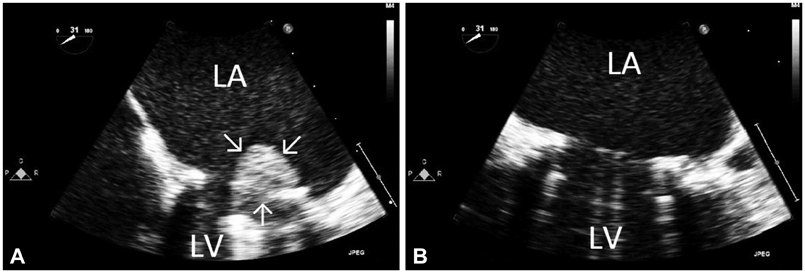Korean Circ J.
2014 Jul;44(4):268-270. 10.4070/kcj.2014.44.4.268.
Potential Inherited Causes of Recurrent Prosthetic Mitral Valve Thrombosis in a Pregnant Patient Suffering from Recurrent Miscarriage
- Affiliations
-
- 1Department of Cardiology, Kosuyolu Kartal Heart and Research Hospital, Istanbul, Turkey. macitkalcik@yahoo.com
- 2Department of Cardiology, Faculty of Medicine, Kars Kafkas University, Kars, Turkey.
- KMID: 2223889
- DOI: http://doi.org/10.4070/kcj.2014.44.4.268
Abstract
- An effective anticoagulation is critical in pregnant patients with prosthetic heart valves. Inherited disorders may interfere with the coagulation cascade and may be associated with obstetrical complications as well as with prosthetic valve-derived complications. The patient in the present case had a history of recurrent prosthetic heart valve thrombosis (PHVT) despite an effective anticoagulation. She underwent a thrombolysis with low-dose prolonged infusion of tissue-type plasminogen activator for the management of her recurrrent prosthetic valve thrombosis. The genetic testing showed homozygous mutations of methylenetetrahydrofolate reductase (MTHFR) A 1298 C and heterozygous mutations of beta-fibrinogen 455 G-A. Inherited disorders such as MTHFR A 1298 C and fibrinogen 455G/A polymorphisms may be involved in the pathogenesis of recurrent PHVT and/or pregnancy loss.
MeSH Terms
Figure
Reference
-
1. Chan WS, Anand S, Ginsberg JS. Anticoagulation of pregnant women with mechanical heart valves: a systematic review of the literature. Arch Intern Med. 2000; 160:191–196.2. D'Uva M, Micco PD, Strina I, Placido GD. Recurrent pregnancy loss and thrombophilia. J Clin Med Res. 2010; 2:18–22.3. Özkan M, Gündüz S, Biteker M, et al. Comparison of different TEE-guided thrombolytic regimens for prosthetic valve thrombosis: the TROIA trial. JACC Cardiovasc Imaging. 2013; 6:206–216.4. Özkan M, Çakal B, Karakoyun S, et al. Thrombolytic therapy for the treatment of prosthetic heart valve thrombosis in pregnancy with low-dose, slow infusion of tissue-type plasminogen activator. Circulation. 2013; 128:532–540.5. Ozkan M, Biteker M, Duran NE, Yildiz M. Images in cardiovascular medicine. Huge prosthetic mitral valve thrombosis in a pregnant woman. Circulation. 2009; 120:e151–e152.6. Brenner B. Haemostatic changes in pregnancy. Thromb Res. 2004; 114:409–414.7. James AH, Jamison MG, Brancazio LR, Myers ER. Venous thromboembolism during pregnancy and the postpartum period: incidence, risk factors, and mortality. Am J Obstet Gynecol. 2006; 194:1311–1315.8. Spiroski I, Kedev S, Antov S, et al. Methylenetetrahydrofolate reductase (MTHFR-677 and MTHFR-1298) genotypes and haplotypes and plasma homocysteine levels in patients with occlusive artery disease and deep venous thrombosis. Acta Biochim Pol. 2008; 55:587–594.9. Kim SY, Park SY, Choi JW, et al. Association between MTHFR 1298A>C polymorphism and spontaneous abortion with fetal chromosomal aneuploidy. Am J Reprod Immunol. 2011; 66:252–258.10. Bozdemir V, Kirimli O, Akdeniz B, et al. The association of beta-fibrinogen 455 G/A gene polymorphism with left atrial thrombus and severe spontaneous echo contrast in atrial fibrillation. Anadolu Kardiyol Derg. 2010; 10:209–215.11. Weng X, Cloutier G, Genest J Jr. Contribution of the -455G/A polymorphism at the beta-fibrinogen gene to erythrocyte aggregation in patients with coronary artery disease. Thromb Haemost. 1999; 82:1406–1411.
- Full Text Links
- Actions
-
Cited
- CITED
-
- Close
- Share
- Similar articles
-
- Thrombolysis for Prosthetic Mitral Valve Thrombosis: 3 cases report
- Use of Femorofemoral Bypass for Life Saving before the Emergency Replacement of Thrombotic Prosthetic Mitral Valve
- Recurrent Prosthetic Mitral Valve Dehiscence due to Infective Endocarditis: Discussion of Possible Causes
- Thrombolytic Treatment of Prosthetic Valve Thrombosis
- A Successful Dissolution of an Obstructive Prosthetic Mitral Valve Thrombus: Sequential Two and Three Dimensional Transesophageal Echocardiography Examination


